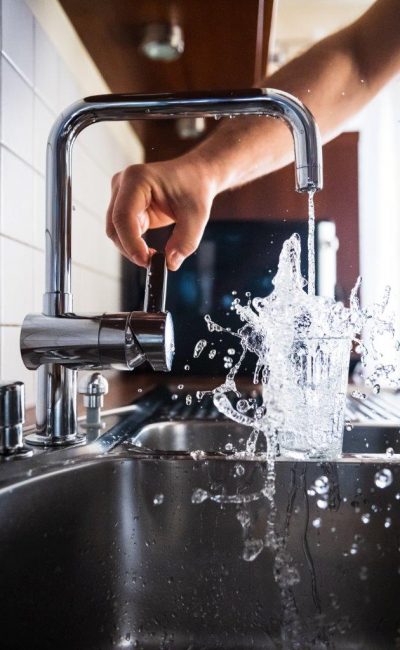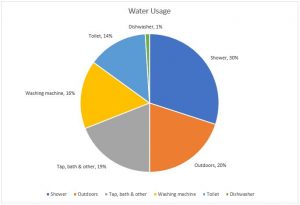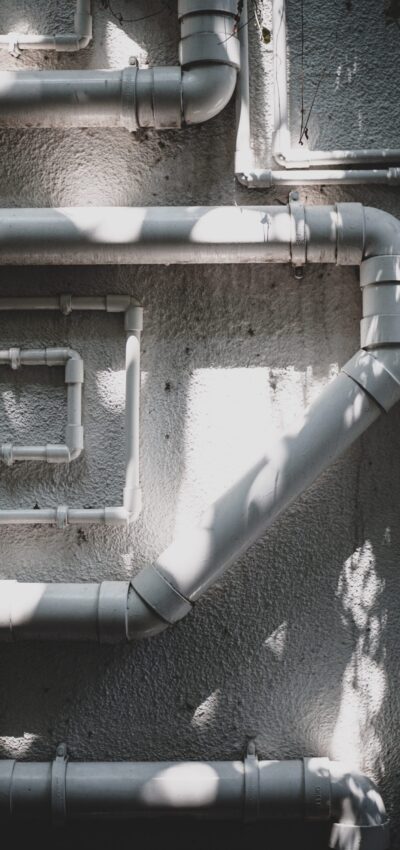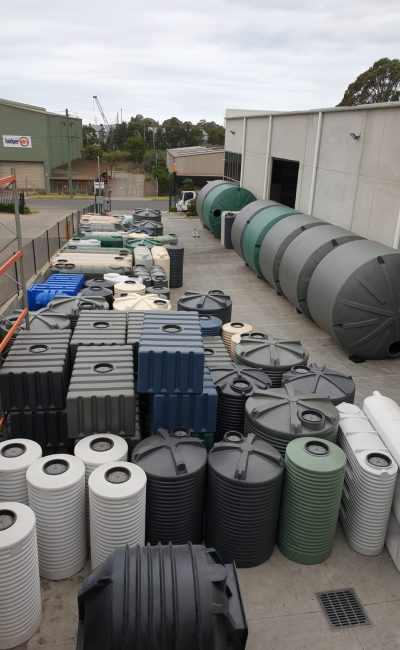
Rainwater harvesting
Rainwater harvesting refers to a system which is set up to collect and store rainwater for ongoing or later use after any necessary treatment. Rainwater harvesting can be done in domestic, agricultural or commercial settings, for purposes such as washing, irrigation or even drinking.
In order to harvest rainwater, the following components are usually required:
- A hard surface such as a roof, from which the rainwater runs off and is collected
- A method of channelling the rainwater from the roof or hard surface; typically pipes, gutters, downpipes and drains
- Rainwater tanks or another storage system in which the collected rainwater is stored
- Means of distributing the rainwater from the tanks (or other storage container), such as hoses, pipes and pumps
The main benefits of rainwater harvesting include:
- Access to nature’s free supply of water, which is pure, pH neutral and chemical free
- Immediate savings to your water bill
- Care for the environment, by reducing runoff and associated impacts like soil erosion and contamination of local ecosystems
- Your water supply is constantly topped up with every rainfall
- Reduced dependence on town water and ground water and pressure on local stormwater
- Your own backup supply of water which is not limited by town water restrictions
- Increased property value with the installation of a rain harvesting system
On average each of us uses around 150 litres of water per day, which totals around 55,000 litres per year! Broken down into percentages, this looks something like the below:
- 30% shower
- 20% outdoors
- 19% taps, bath & other
- 16% washing machine
- 14% toilet
- 1% dishwasher

By connecting a rain harvesting system to your bathroom/s and laundry, you can replace a large percentage of your current town water usage with free rainwater, depending, of course, on how much rainwater you can catch.
Refer to the question ‘what does my average water usage look like’, and you will see that 30% of the average water usage is in showers alone, and that 79% is used between bathrooms and laundry usage.
The two main considerations when it comes to harvesting rainwater from your roof are the slope of the roof and the roof material. Despite the name ‘flat roof’, these do have a slight angle to them which will still allow rainwater runoff, as with a pitched roof. With a slope for which the rainwater to run off and a gutter for it to run into, your roof should work just fine as a rainwater collection surface.
Most roof materials are suitable for collecting rainwater; however, some are more effective than others. Metal roofing or plastic sheeting (such as on a greenhouse) is a great choice for allowing rainwater to flow easily into your gutters. A clay or concrete tile roof will also work however it has a much lower collection efficiency simply because the porous nature of the material absorbs so much water.
If you are harvesting rainwater for human consumption, you should check with the roof manufacturer whether the material is suitable for contact with drinking water. See the next question for further information on this point.
Generally, yes, you can.
Rainwater itself is clean, pure and safe for drinking, however you should always be wary of other factors such as chemical contamination and debris. Possible contaminants include roofing materials, plumbing materials, bird droppings, rodent droppings, bacteria or parasites. Providing your rainwater harvesting system is well maintained, and the rainwater is clear with no unusual taste or smell, it is unlikely to pose a health risk.
Some steps you can take to make your rainwater safe for drinking include:
- Verify with the roofing manufacturer that the roofing material is suitable for contact with drinking water
- Utilise drinking water (not stormwater) grade pipes when installing the rainwater harvesting system
- Choose a polyethylene tank manufactured from material certified as suitable for contact with drinking water
- Utilise a first flush diverter to divert contaminants in the initial flow of rainwater
- Maintain your system by regularly cleaning out your gutters and tank screens
- Flush rainwater taps and boil rainwater prior to use to remove any dissolved contaminants
Rainwater collected from a rainwater harvesting system can be used at your discretion. You can connect it up to your internal plumbing and use it for your main water supply, or you can use it externally only, direct from the tank.
Rainwater uses are generally categorised as either potable (safe for human consumption) or non-potable.
Potable uses include:
- Cooking
- Drinking
- Showering/bathing
- Washing dishes
Non-potable uses include:
- Irrigation
- Washing clothes
- Cleaning
- Flushing toilets
- Washing vehicles or machinery
- Filling ponds or pools
- Livestock watering

Water storage
A rainwater tank is the water storage component of your rainwater harvesting system.
Particularly if you’re building a new home or doing renovations to your existing home, many local government regulations will require you to install a rainwater tank for toilet flushing, laundry and outside use, to meet environmental sustainability targets. Some local councils will even offer a rebate for doing so.
Saving rainwater is particularly important in Australia; the driest inhabited continent, where our dry climate and poor water infrastructure means that we have extensive periods of drought and water shortage.
A rainwater tank gives you your own supply of pure natural water, saving you money off your water bill and helping preserve your local environment.
The two factors that determine how much water you can collect are the rainfall in your area and the size of your collection surface (i.e. your roof). Wherever you live, your average annual rainfall will determine how much rainwater you can possibly harvest in a year. The surface area of your roof (or rainwater collection area) equates to the rainwater runoff that will yield.
To calculate an estimate of how much rainwater you can collect, you can multiply your collection area (in square metres) by annual rainfall (in millimetres) to equal litres of rainwater yielded from your roof.
Now the amount of rainwater you can store depends on the size of the tank, which should be chosen based on the amount you can collect, the amount of water you use, and any regulatory requirements.
See more on this topic here.
Obviously, this is completely dependent on how much rain you get.
You can do a rough estimate of how long it will take to fill your tank by calculating the run-off from your roof, using the conversion rate of 1mm of rain over 1 sqm of roof being equivalent to 1 litre into your tank.
For example, if you are catching rainwater from 250 sqm of roof, and you have a 5,000-litre rainwater tank, it would take 20mm of rain to fill your tank, since 20mm multiplied by 250 square metres equals 5000 litres.
Keeping the water in your rainwater tank clean is very simple. Both a first flush diverter and a mosquito proof inlet strainer will effectively remove both contaminants and debris from your water supply.
A first flush device diverts the initial portion of water runoff away from your tank so that dust, bird droppings and other contaminants do not reach your water supply.
A mosquito proof inlet strainer is made of very fine mesh which will both prevent debris from entering the tank as well as insects and mosquitoes. Rotoplas rainwater tanks are supplied with a mosquito proof inlet strainer fitted.
Roof catchments and gutters should be regularly inspected and maintained, and tank screens should be cleaned out regularly.

Choosing a rainwater tank
Rainwater tanks come in all shapes, sizes and materials, and even in above and below ground types. To decide on a type of tank, you should consider:
- Where are you going to put it?
- How much space do you have available?
- What are you going to use it for?
- How much water do you want to store?
- What is the nature of the surrounding environment?
Once you have answered these questions, you should determine which factors are higher priority and choose a tank type accordingly.
This depends on how much rainwater you can collect, and how much water you use.
You can use the following formula to work out how much rainwater you will be able to harvest from your roof:
Area’s average rainfall (mm) x Collection surface area (m2).
You will also need to consider both:
- Regulatory requirements– check your local council requirements for minimum or maximum water storage volumes, particularly if you need to obtain a BASIX certificate, and;
- Usage requirements– this will depend whether you intend to connect rainwater supply to your house or if you will just be using rainwater for your gardens. A quick way to determine your water usage is by examining your most recent water bill.
See more about this topic on this blog post.
It depends what type of tank you are looking for.
Round water tanks provide the greatest choice and range from 500-litre through to 22,700-litre, in a variety of tall and squat options.
Underdeck water tanks are available in 2000-litre capacity, with both a tall and a squat option.
Slimline water tanks range from 1500-litre through to 5000-litre capacity.
You can view all of our rainwater tanks here.
Yes, but only ever so slightly.
All sizes are approximate due to the variable shrinkage of polyethylene during manufacture and can be up to 10mm different to the listed dimensions.
It is recommended that you measure your space and choose a tank that has plenty of clearance to ensure it will fit into the available space.
This largely depends on what you are trying to achieve.
If you are looking for a space efficient solution, then typically a slimline water tank is the best shape for you. This is because a slimline water tank features a narrow footprint, making up its capacity in either length or height (or both).
If you are looking for maximum water storage capacity, then a round water tank is the way to go as this is the simplest way to increase your volume.
If you have a steep or difficult site to work with, perhaps an underdeck water tank suits your needs best, since it can be installed out of the way under a deck or floor.
Our tanks are made from UV resistant polyethylene certified to AS/NZS 4766, suitable for contact with drinking water.
Our rainwater tanks come in over 20 colours, which you can view on the colour chart here.
Australian homes and landscapes present a variety of colour schemes, so we offer the full Colorbond range plus some extras, to ensure you can match a rainwater tank to your home, shed or surrounding environment.
There is no additional cost for your colour choice.
In summary, the main factors you need to take into consideration when choosing a rainwater tank are:
- The amount of rainwater you can collect
- The storage capacity you are looking for
- Where you are going to put your rainwater tank
- The amount of space you have available
- Whether you want to blend or feature your tank on your property

Installing a rainwater tank
In most cases, no, however you should check with your local council to be sure. Here’s some info from Sydney Water:
Rainwater tanks are large, very heavy when full and can cause harm if they aren’t installed or maintained correctly. A number of regulations are in place to help ensure your tank is safe and suitable.
Contact your local council to see if they have any requirements you need to comply with. This may include a maximum height, placement, or distance from your property boundary.
Tanks that can store a maximum of 10,000 litres of water don’t normally need council approval. However, there are a number of conditions you must comply with.
Refer to the State Environmental Planning Policy (Exempt and Complying Development Codes) 2008 and scroll down to the Subdivision 32 and Subdivision 33 headings.
You can, however it is not recommended, and may void the manufacturer’s warranty.
It is instead recommended that your rainwater tank be installed by a licensed plumber with experience in installing rainwater tanks. Regardless of whether you, or a plumber, install your tank/s, the following instructions must be noted:
- The tank site must be flat, level, well compacted and free from any rocks, stones and sharp objects.
- The prepared site must be at least 600mm larger in diameter than the rainwater tank.
- A reinforced concrete slab is the ideal tank pad and must be greater than the diameter of the rainwater tank.
- If a material other than concrete is used, a retaining wall or surround must be provided to prevent erosion.
- The overflow must be piped well clear of the tank to avoid undermining of the tank base.
- A flexible hose of at least 300mm must be installed after the outlet valve to absorb any shocks or movement.
- Modular tanks must be installed on a reinforced concrete slab.
Generally speaking, you can install a rainwater tank anywhere on your property where you have space for a flat base lower than the collection area, and larger in diameter than the tank.
However, you should also consider:
- Any council regulations, such as minimum distance from your boundary
- Space for pipework
- The location of the collection surface and the main use of your rainwater, to minimise pipework
- Making use of gravity if you have a sloped property, to minimise required pump pressure
- Making use of hidden or otherwise unused spaces, such as under a deck or behind a shed
- Being careful not to obstruct windows
- Blending your tank with its environment
Slimline water tanks
- Leaf (inlet) strainer at one end
- Provision for overflow at either end (overflow supplied loose)
- Brass outlets moulded into the tank, with one at each end at the base of the tank, and one at one end of the tank (opposite end to the inlet strainer) at bucket height.
Round water tanks
The location of fittings on a round tank is usually referred to as a position on a clock face. These locations vary from tank to tank, as follows.
RWT500S, RWT1000, RWT1350, RWT1675
- Leaf (inlet) strainer in the centre of the roof
- Provision for overflow at either 3 o’clock or 9 o’clock (overflow supplied loose)
- Brass outlets moulded into the tank at 6 o’clock at both the base of the tank and bucket height
RWT1000S, RWT2500, RWT2500S, RWT5000
- Leaf (inlet) strainer at 4 o’clock
- Provision for overflow at either 3 o’clock or 9 o’clock (overflow supplied loose)
- Brass outlets moulded into the tank at 12 o’clock and 6 o’clock at the base of the tank
RWT3500, RWT7000
- Leaf (inlet) strainer at 12 o’clock
- Provision for overflow at either 1 o’clock or 11 o’clock (overflow supplied loose)
- Brass outlets moulded into the tank at 3 o’clock and 9 o’clock at the base of the tank
RWT22700
- Leaf (inlet) strainer at 12 o’clock
- Provision for overflow at either 12 o’clock, 3 o’clock, 6 o’clock or 9 o’clock (overflow supplied loose)
- Brass outlets moulded into the tank at 3 o’clock and 9 o’clock at the base of the tank
Underdeck water tanks
- Leaf (inlet) strainer in the centre of the roof
- Multiple provisions for overflow using any flat section of the tank (overflow supplied loose)
- BSP threaded outlets moulded into the tank, with one at each end at the base of the tank
Most individual product pages also have specification sheets which you can view for further details.
Our rainwater tanks are supplied with inlet strainers, overflows and outlets, however additional accessories that you may require to fully connect and protect your rainwater supply (depending on your application) include:
- Ball valve or tap
- Pump
- Piping
- Additional outlets
- First flush diverter
- Filter or leaf eater
- Tank level indicator
Yes, multiple rainwater tanks can be linked together.
You can call us to discuss this or speak to a licensed plumber with experience in rainwater tanks.
Depending on how you intend to use your tank water, it is not strictly necessary to install a pump with your tank, however you will need a pump if you would like your rainwater to flow with pressure similar to your mains water.
If you do purchase a pump it is also recommended that you fit a pump cover to protect your pump from the elements and to reduce noise.
This obviously depends on how well it is looked after. In saying that, we have been operating for 15 years and have had almost no reports of product failure to date.
With regular maintenance, there is no reason why a tank can’t last for upwards of 20 years.
Rotoplas rainwater tanks have a 10-year warranty.
We take pride in our product quality and workmanship and we deliberately strive to provide guaranteed trouble-free products and services that can be repeatedly relied on. With confidence we cover our rainwater tanks with a 10-year warranty (5 years for underground tanks) for your peace of mind.
Register your product warranty here.
In order to maintain domestic rainwater tanks, the Australian Department of Health recommends (as seen here):
Once a rainwater tank is installed, it is recommended that the following components of the roof catchment and tank be inspected at least every six months:
- Gutters – they generally will need cleaning as well as inspection. If inspection finds large amounts of leaf material or other debris, then the inspection and cleaning frequency may need to be increased.
- Roof – check for the presence of accumulated debris including leaf and other plant material. Accumulated material should be cleared. If tree growth has led to overhanging branches these should be pruned.
- Tank inlets, insect-proofing and leaf filters – if necessary, these should be cleaned and repaired.
- Tank and tank roof – check structural integrity of the tank including the roof and access cover. Any holes or gaps should be repaired.
- Internal inspection – check for evidence of access by animals, birds or insects including the presence of mosquito larvae. If present, identify and close access points. If there is any evidence of algal growth (green growth or scum on or in the water), find and close points of light entry.
- Pipework – check for structural integrity. Sections of pipework that are not self-draining should be drained. Buried pipework, such as with ‘wet systems’, can be difficult to drain or flush. Where possible drainage points should be fitted.
In addition to six-monthly inspections, tanks should be inspected every 2-3 years for the presence of accumulated sediments. If the bottom of the tank is covered with sediment the tank should be cleaned.
Rainwater tanks can become a significant mosquito breeding site when they are no longer required or when they fall into disrepair. Tanks that are no longer required should be drained, cut up and removed to an appropriate waste disposal site.

Getting a rainwater tank from Rotoplas
It seems a lot of tanks on the market compromise either quality or aesthetics, but ours have been specifically designed for both. Here’s a few pointers about our tanks:
- You can trust their strength. Rotoplas tanks are designed and structurally tested by an engineer using FEA testing, and we ensure our tanks can withstand pressure with features like corrugations and ribs.
- You can place them out in the open sunlight without fear, since they are manufactured from UV-resistant material.
- We back your purchase with a 10-year manufacturer’s warranty.
- You get complimentary brass fittings which we mould into the tanks for a high quality, leak proof seal.
- You can add lifetime value to your home with the superior aesthetic quality of our tanks- there is always something to be said for smart looking design!
Rotoplas rainwater tanks are manufactured in Unanderra; a suburb of the city of Wollongong, NSW, about 100km south of Sydney. We are a family owned Australian manufacturing business supporting local jobs and communities. You can view us on Google Maps here.
Yes!
We deliver our rainwater tanks to most of Eastern NSW, from Newcastle in the north through Sydney, Illawarra and Canberra, and down to Bega on the south coast.
To make it easier for you, we’ve made a page specifically for delivery details, with a map of our delivery regions.
Check out our delivery details page here.
The short answer is usually no. We have dozens of sizes and over 20 colours, so it’s simply impossible for us to stock every size and colour!
Whilst we do make our rainwater tanks to order, we do occasionally have stock of popular sizes and colours, so you are welcome to give us a call on 1800 218 000 to check, if you are urgently needing a tank.
Alternatively, you can place an order for production and delivery within approximately 3-4 weeks.
Yes, you are welcome to collect your tank/s.
If you wish to do so, please advise at the time of order placement, upon which we will arrange to call you when it is ready for collection. We will then require you to advise us when you intend to collect the tank so we can ensure it is accessible.
It will be your responsibility to ensure your load is safe and secure before leaving our site.
Yes, Rotoplas rainwater tanks are available to order from leading hardware and plumbing stores including Mitre 10, Eagles Plumbing, Swan Plumbing, Tradelink, Reece, Plumbers’ Supplies Co-op and some private tank retailers including online stores.
Please contact us for a full list of stores in your area.
It is important that you check the dimensions of the tank and confirm the colour by checking against a Colorbond colour swatch at a local hardware store, before you place your order.
If for some reason the colour or size is incorrect, we do accept returned rainwater tanks. It is important to note that the following conditions apply (obviously this only applies to change of mind returns, and your consumer rights in case of manufacturing defects apply for warranty returns):
- Your tank must be in original condition suitable for resale
- You will incur a 30% restocking fee as well as the cost of return freight
- Returns must be initiated within 7 days of purchase
